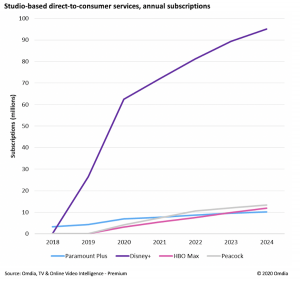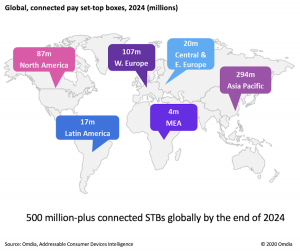
After more than 35 years of operation, TBI is closing its doors and our website will no longer be updated daily. Thank you for all of your support.
TBI Tech & Analysis: Where next for pay-TV in a streaming future?
Fateha Begum, principle analyst at TBI sibling OMDIA, tells Richard Middleton about the key trends facing pay-TV providers as they grapple with the challenges of studios and IP owners going over-the-top (OTT).
As content providers follow consumers and turn to OTT, the traditional content delivery model disintegrates. Pay-TV services have always played the role of content aggregator and created packages to suit customer needs, but that role is in being challenged like never before.
However, a key advantage for pay-TV operators is the customer data they have collected through owning the platform on which they deliver content. Although some of this – as well as revenue – will be lost with the move to OTT apps, pay-TV services can reinforce their role as content aggregator in the household.
Rapid action required…
This ‘aggregation’ role becomes more important as the number of streaming services increases and consumers must manage multiple accounts. However, timing is everything, because cord-cutting is now spreading beyond the US and will be increased by the Covid-19 pandemic, which coincided with the launch of direct-to-consumer (D2C) services from globally recognised brands. Pay-TV operators still benefit from wide reach and ownership of a high-powered media device: the set-top box (STB). The STB represents a key connected device in the home, one that is managed by the pay-TV operator and is a key driver of value perception for pay TV against OTT services (see below for more on this).
…fuelled by Covid’s ‘convenience’ effect
The transition from pay-TV to OTT video occurred faster than forecast. The rate of new OTT signups will slow down in 2021 compared with 1H20, but total subscriptions are already ahead of the predicted curve. While cord-cutting has largely been a US phenomenon with some instances globally, lockdown measures have hindered many pay-TV installations, particularly of direct-to-home services that require engineer visits. This further pushed households to OTT services and highlighted the greater convenience and flexibility on offer, particularly in terms of access to devices.
Content demands mean more services…
Consumers will increasingly expect flexibility to meet content needs. The average number of services accessed by consumers has crept up over the years, particularly with the rise of social video and OTT subscription services. Although the growth rate of online subscriptions will slow down in 2021, driven by consumers canceling video services subscribed to during lockdowns, the average number of services used will be higher than in previous years.
…and churn
This means churn will become even more of a problem in 2021 following high OTT uptake in the first half of 2020. Consumers are now more aware of content availability across services and the ability to dip in and out of services to meet their content needs. While exclusives and original content have been leveraged by subscription platforms to drive uptake, range of content will grow in importance for engagement and retention. Consumers who sign up to a service for exclusive content are more likely to subsequently churn. It is vital for services to be a part of the services stacked, rather than the services consumers dip in and out of.
Pay-TV’s opportunity to box clever…
The role of the pay-TV operator will evolve from linear channel packaging to OTT app integration via the STB. The STB is one of the most advanced living-room devices and, in conjunction with service providers’ existing customer relationships, presents a great opportunity for pay-TV operators to revitalise their role as content aggregators through partnerships. Pay-TV services will become service agnostic to compete with other devices as consumers increasingly want access to all their video services in one place.
…and integrate
Deeper integration will be required because the addition of OTT apps will no longer serve as a churn-reduction mechanism. Usage of OTT apps on the STB reached unprecedented levels in 2020. Previously, usage of pay-TV increased and OTT fell with STB app usage, but this trend reversed for many operators in 2020. High app engagement comes with churn risk, driving consumers on to services accessible across other devices. Further, STB connections and app usage rates will rise. The STB has seen many advances and innovations in the past decade as on-demand viewing rose, and there was a shift toward hybrid STBs. The benefits of the STB will need to be reinforced through 4K and friendly user interfaces. OTT app integration in the EPG along with improved content recommendations and search capabilities (including voice) will drive further value and engagement.
Fateha Begum is principal analyst for consumer devices & media at OMDIA, the global technology research powerhouse which, like TBI, is part of Informa. The data above comes from her recent report, 2021 Trends to Watch: Consumer Trends In A Connected World.






